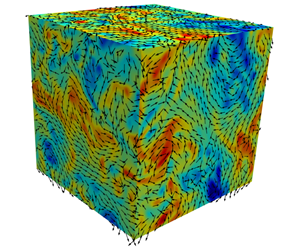Crossref Citations
This article has been cited by the following publications. This list is generated based on data provided by
Crossref.
Inagaki, Kazuhiro
2021.
Scale-similar structures of homogeneous isotropic non-mirror-symmetric turbulence based on the Lagrangian closure theory.
Journal of Fluid Mechanics,
Vol. 926,
Issue. ,
Bos, Wouter J.T.
2021.
Three-dimensional turbulence without vortex stretching.
Journal of Fluid Mechanics,
Vol. 915,
Issue. ,
Milanese, Lucio M.
Loureiro, Nuno F.
and
Boldyrev, Stanislav
2021.
Dynamic Phase Alignment in Navier-Stokes Turbulence.
Physical Review Letters,
Vol. 127,
Issue. 27,
Kitamura, Takuya
2021.
Constant-energetics control-based forcing methods in isotropic helical turbulence.
Physical Review Fluids,
Vol. 6,
Issue. 4,
Agoua, Wesley
Favier, Benjamin
Delache, Alexandre
Briard, Antoine
and
Bos, Wouter J. T.
2021.
Spontaneous generation and reversal of helicity in anisotropic turbulence.
Physical Review E,
Vol. 103,
Issue. 6,
Vieweg, Philipp P.
Scheel, Janet D.
Stepanov, Rodion
and
Schumacher, Jörg
2022.
Inverse cascades of kinetic energy and thermal variance in three-dimensional horizontally extended turbulent convection.
Physical Review Research,
Vol. 4,
Issue. 4,
Yu, Changping
Hu, Running
Yan, Zheng
and
Li, Xinliang
2022.
Helicity distributions and transfer in turbulent channel flows with streamwise rotation.
Journal of Fluid Mechanics,
Vol. 940,
Issue. ,
Verma, Mahendra K
2022.
Variable energy flux in turbulence.
Journal of Physics A: Mathematical and Theoretical,
Vol. 55,
Issue. 1,
p.
013002.
Selukov, D.G.
and
Stepanov, R.A.
2022.
Shell model of turbulent viscosity for the boundary layer.
Computational Continuum Mechanics,
Vol. 15,
Issue. 3,
p.
363.
2023.
Numerical study of the precession-driven flow inside a sphere using helical wave decomposition.
Physics of Fluids,
Vol. 35,
Issue. 4,
Shao, Xin
Zhang, Ning
and
Tang, Jie
2023.
A Physical Model for the Observed Inverse Energy Cascade in Typhoon Boundary Layers.
Geophysical Research Letters,
Vol. 50,
Issue. 18,
Meng, Zhaoyuan
Shen, Weiyu
and
Yang, Yue
2023.
Evolution of dissipative fluid flows with imposed helicity conservation.
Journal of Fluid Mechanics,
Vol. 954,
Issue. ,
Ren, Hehe
Xiong, Xue-Lu
Yang, Jie
Ke, Shitang
Laima, Shujin
Chen, Wen-Li
and
Li, Hui
2024.
A novel formulation of wind velocity spectrum incorporating rainfall influence.
Journal of Wind Engineering and Industrial Aerodynamics,
Vol. 252,
Issue. ,
p.
105816.
Chen, Sihan
de Wit, Xander M.
Fruchart, Michel
Toschi, Federico
and
Vitelli, Vincenzo
2024.
Odd Viscosity Suppresses Intermittency in Direct Turbulent Cascades.
Physical Review Letters,
Vol. 133,
Issue. 14,
Dudley, Ethan
2024.
Necessary and sufficient conditions for Kolmogorov’s flux laws on
T
2
and
T
3
.
Nonlinearity,
Vol. 37,
Issue. 9,
p.
095005.
Yan, Zheng
Wu, Junfeng
Lei, Zhu
Wang, Jianchun
Wang, Lifeng
Li, Xinliang
and
Yu, Changping
2024.
Helicity transfer in compressible turbulent flows.
Physical Review Fluids,
Vol. 9,
Issue. 9,
Nekkanti, Akhil
Pickering, Ethan
Colonius, Tim
and
Schmidt, Oliver T.
2024.
Nonlinear Interactions in Non-Resonant, Homogeneous Turbulent Jets.
Mohamed, A.
Delache, A.
Godeferd, F. S.
Liu, J.
Oberlack, M.
and
Wang, Y.
2024.
Maximization of inertial waves focusing in linear and nonlinear regimes.
Physical Review Fluids,
Vol. 9,
Issue. 9,
Chen, Chang Hsin
and
Bhaganagar, Kiran
2024.
Turbulent cascading in Buoyant plumes.
Environmental Fluid Mechanics,
Vol. 24,
Issue. 5,
p.
991.
